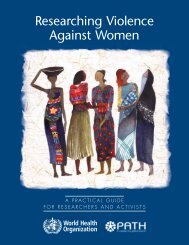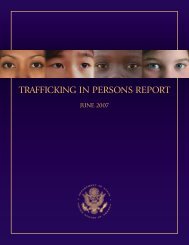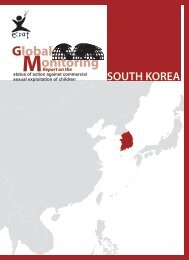Download PDF - Violence Against Children - East Asia and the ...
Download PDF - Violence Against Children - East Asia and the ...
Download PDF - Violence Against Children - East Asia and the ...
You also want an ePaper? Increase the reach of your titles
YUMPU automatically turns print PDFs into web optimized ePapers that Google loves.
Cambodia<br />
To fur<strong>the</strong>r underst<strong>and</strong> how children’s<br />
involvement can impact on <strong>the</strong> quality of life<br />
experienced by children, primary research<br />
was undertaken in Cambodia where child<br />
participation is part of a strategy to prevent<br />
child abuse or neglect. (Tools <strong>and</strong> techniques<br />
used are discussed with regard to Cambodia<br />
<strong>and</strong> o<strong>the</strong>r countries covered in this study.<br />
Practical applications of child participatory<br />
approaches linked to broader development<br />
activity are explored in <strong>the</strong> Sri Lanka <strong>and</strong> <strong>the</strong><br />
Philippines chapters.)<br />
Child protection concerns<br />
identified<br />
Support for increased child participation was<br />
prompted by research into child trafficking by<br />
World Vision <strong>and</strong> <strong>the</strong> International<br />
Organization for Migration (IOM) in 1998,<br />
which identified <strong>the</strong> following risk factors:<br />
1. An older sister, relative or friend is<br />
already involved in prostitution.<br />
2. The parents of <strong>the</strong> girl are separated,<br />
divorced or have remarried.<br />
3. One or both parents are dead <strong>and</strong> <strong>the</strong> girl<br />
is living with relatives or friends.<br />
4. The family is dependent on casual work,<br />
in debt, or in extreme poverty.<br />
5. The girl is of suitable age for <strong>the</strong> sex industry.<br />
6. The girl is mentally weak.<br />
7. There is community indifference or<br />
powerlessness over <strong>the</strong> presence of<br />
trafficking or prostitution that has<br />
involved children.<br />
An integrated approach<br />
<strong>Children</strong>’s/youth clubs <strong>and</strong> associations were<br />
developed in Cambodia in 1999 by World<br />
Vision in partnership with Village<br />
Development Committees, local schools <strong>and</strong><br />
children. Once <strong>the</strong> structure was established,<br />
o<strong>the</strong>r links have been made with <strong>the</strong><br />
<strong>Children</strong> Assistance for Mobilisation <strong>and</strong><br />
Participation group (CAMP), Project <strong>Against</strong><br />
Domestic <strong>Violence</strong> (PADV), <strong>and</strong> <strong>the</strong> human<br />
rights group LICADHO. A safe meeting place<br />
for children through clubs is a feature of<br />
work in 11 villages with a combined<br />
population of 29,760, in two provinces. At<br />
<strong>the</strong> time of writing, <strong>the</strong>re are 11 clubs with<br />
1,574 club members.<br />
The clubs’ strategy has addressed risk<br />
factors 3, 5, 6 <strong>and</strong> 7, while income generation<br />
in broader development activity has<br />
addressed point 4. The objectives of <strong>the</strong><br />
establishment of children’s/youth clubs are:<br />
• to promote awareness of child rights <strong>and</strong><br />
child protection issues in <strong>the</strong> community<br />
• to help children progress in study, play,<br />
discussion, teaching each o<strong>the</strong>r, <strong>and</strong><br />
releasing <strong>the</strong>ir personal stress<br />
• to assist children to help <strong>the</strong>mselves <strong>and</strong><br />
each o<strong>the</strong>r<br />
• to improve knowledge of <strong>the</strong> Khmer<br />
culture, tradition, <strong>and</strong> civilised behaviour<br />
through children’s/youth activities<br />
• to build community people’s underst<strong>and</strong>ing<br />
about <strong>the</strong> importance <strong>and</strong> value of children<br />
through <strong>the</strong> club activities<br />
• to encourage <strong>and</strong> give opportunity for<br />
children to be a role model <strong>and</strong> resource in<br />
<strong>the</strong> village <strong>and</strong> community, <strong>and</strong><br />
• to give opportunity for children to<br />
participate <strong>and</strong> speak out about <strong>the</strong>ir<br />
concerns <strong>and</strong> issues, in public <strong>and</strong> at <strong>the</strong><br />
local/national level.<br />
Methods used reflect a belief that children are<br />
not passive recipients of abuse in need of protection,<br />
but have potential to be actively involved<br />
in streng<strong>the</strong>ning <strong>the</strong>ir own development. 17<br />
“Participation builds life skills <strong>and</strong> enables<br />
selfprotection… Young people who have things<br />
just happen to <strong>the</strong>m without having <strong>the</strong><br />
opportunity to defend <strong>the</strong>mselves or shape<br />
outcomes are more likely to become passive <strong>and</strong><br />
fatalistic. But adole-scents who are encouraged<br />
to express <strong>the</strong>ir opinions <strong>and</strong> feelings, to be<br />
assertive <strong>and</strong> to st<strong>and</strong> up for <strong>the</strong>mselves will be<br />
more likely to have higher self-esteem <strong>and</strong> move<br />
from a position of confidence.” 18<br />
17 Child Development Study Pack, Tear Fund, 1999<br />
18 Hart, R, <strong>Children</strong>’s Participation: The <strong>the</strong>ory <strong>and</strong> practice of involving young citizens in community development <strong>and</strong> environmental care, 1996<br />
34

















